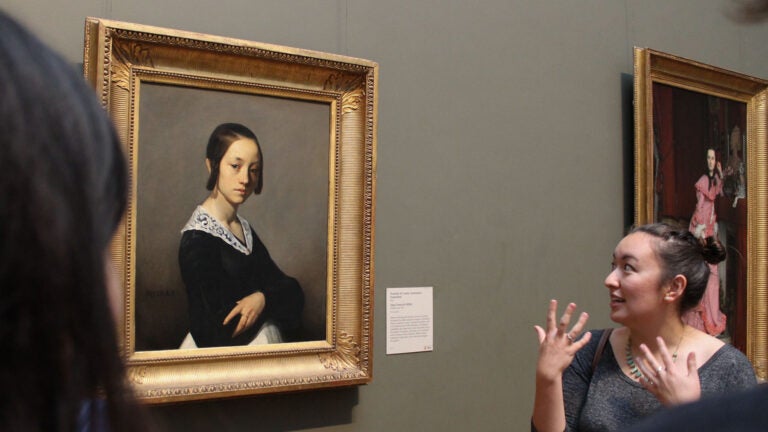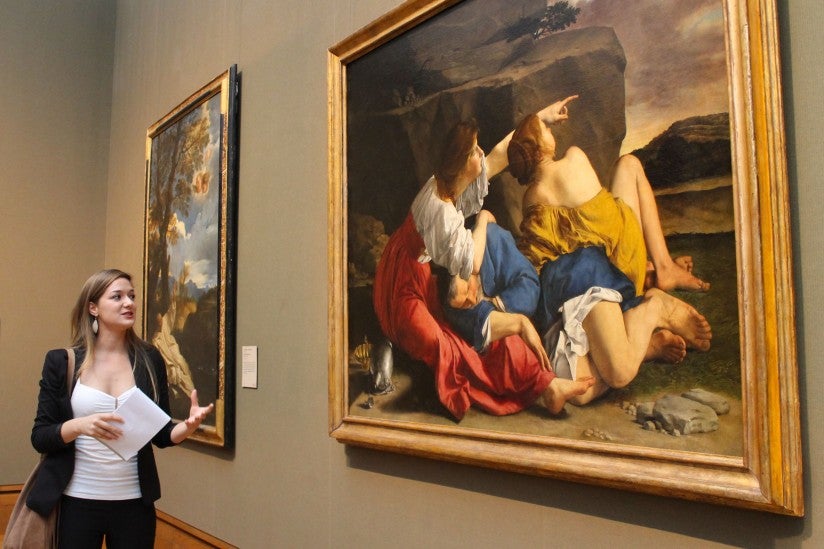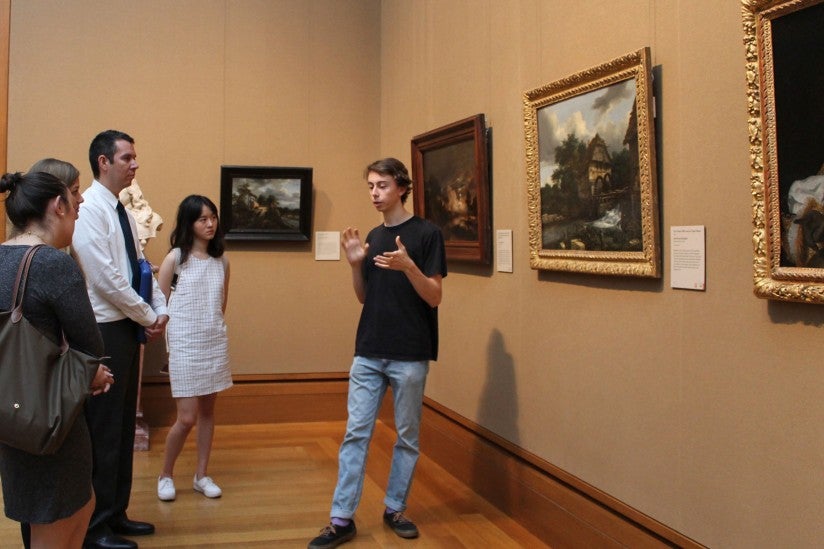
Students connect with artists and their art at Getty Museum
USC Dornsife course teaches Trojans how to hone their observational skills and tell a story about eye-catching paintings
A small crowd of students gathered around a demure portrait of a modestly dressed woman, carefully inspecting her likeness. Painted in 1841 by French artist Jean-François Millet, the woman — clad in a simple black dress with a delicate white lace collar — stands with her arms crossed, looking squarely at the viewer.
“What strikes you immediately about this portrait?” Arielle Murphy asked the group. Murphy is a senior art history major honing her docent skills in “Art History 490: Docents at the Getty Museum,” taught by Hector Reyes at the USC Dornsife College of Letters, Arts and Sciences. The course offers students a chance to become experts in a single room of art at the Getty Museum in Los Angeles.
“Her eyes are her most expressive feature,” replied Aurora Morandi. “Also the fact that she’s hugging her body and crossing her arms — she looks like she is in deep pain and emotional.”

Morandi, a double major in business administration and art history, is also a student in the course. She’s considering a career as an art dealer.
“That’s very interesting that you would point that out,” Murphy noted. She explained that the portrait was painted in the 19th century when painters were looking back to Dutch portraiture of the 17th century. Some of the features, such as the rendering of the eyes, that Morandi called out matched the techniques used by Dutch masters.
As the presentation drew to a close, Reyes, assistant professor (teaching) of art history, assessed Murphy’s performance.
“I want to point out that Arielle did an especially good job of reaffirming the points everyone brought up in their observations, pulling in information from her research. These are the kinds of moves we want to make.”
A win-win for students and community
Throughout the course, students studied the painters and paintings featured in a museum room of their choosing. Through research and exchanges with their classmates, they learned how to tell the story of the artists and their artwork in the collection.
In addition to learning about research resources for art historians, they alternated between meeting on campus at USC and meeting at the museum to get acquainted more closely with their subjects and to practice their docent presentations — which they’ll put to use for the public during the Getty’s College Night on April 24.
Peter Tokofsky, senior public programs specialist at the Getty who worked with the students in the course during the semester, sees a huge benefit for both the students and the community when local universities engage with the museum’s collections. In addition to connecting with museum goers and learning how to present to a wide range of learners, the interaction nurtures critical thinking.
“Aside from the beauty of the art, and that it provides a window onto the past, great art provides us material that is good to ‘think with,’” he said. “Art confronts some of our basic human concerns — storytelling, recording the past, visualizing mythologies, issues of what humanity chooses to preserve and so on. Engagement with art, when thoughtfully cultivated, can help us build a better society.”
Finding joy in the experience
Narrative studies major Zach McLane appreciated the two-unit class for its small group atmosphere and because it situated him on-location with the artwork.

“This allows me to do independent research and get together with a few people to talk about the paintings outside of the formalities of a lecture,” he said. “That was appealing.”
The process of learning about 17th-century Dutch painters such as Roelandt Savery and Jacob van Ruisdael in the room he is studying has given him a deep appreciation for his subject. He admitted that their work was “sparse and seemingly uninteresting” at first glance.
For instance, the painting “Two Water Mills and an Open Sluice” by van Ruisdael depicts an ostensibly benign landscape of water running through a channel bookended by two thatch-roofed structures. In his research, McLane came to learn that the artist intended to capture the tension between nature’s power and human needs.
“Once I figured out what a lot of the paintings are getting at, the research was really fun,” McLane said.
Murphy, who is considering a career in museum education, has been developing a narrative about the history of Millet and his paintings to incorporate into her docent presentation.
“I’ve studied the time period, in terms of art history. Then also what observations I find myself — the more personal experience of how I read the painting,” she explained. “I find a few of the underlying themes that will keep linking formal elements back to the paintings.”
While gaining specialized knowledge through research is an important part of the process, Reyes wants students to find joy in appreciating great works of art — which is what the museum-going experience is all about.
“That to me is always such a great experience, and I want students to start to have that kind of relationship to the paintings and the art. This is about reorienting their research focus to think about what a collaborative viewing experience would be with people,” Reyes said. “There’s no single authoritative way to interpret a painting.”



